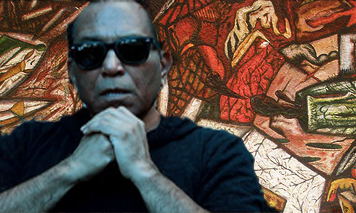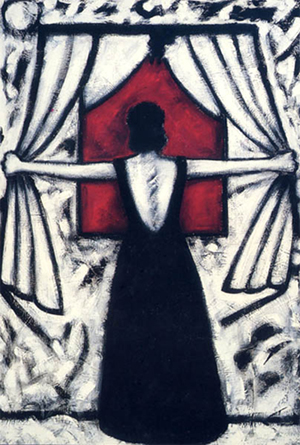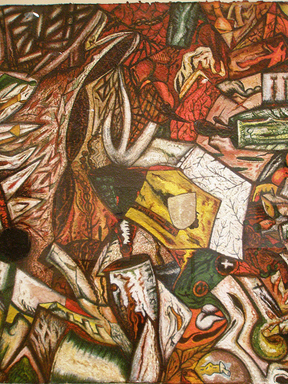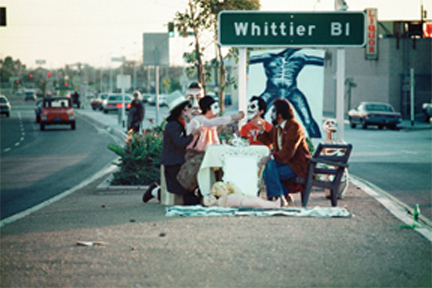Glugio "Gronk" Nicandro
- Artist Glugio Nicandro
- Glugio's Art
- Contributor Edgar Navarro

The work of Nicandro holds elements of the bizarre, where faces and settings are never clear-cut. Facial stimuli are done in groups, as though a face he creates must be part of a larger crowd. Many of his murals also hold elements of Los Angeles, such as airplanes or large building-like structures. His more famous none-abstract paintings are a series called “La Tormenta,” which can be translated to different meanings like “the torment” or “the woman that is tormented.” This series is based on an artists’ take on a piece that is done with an orchestra and soprano singer. These works usually portray a single figure with the back turned towards the viewer, and different backgrounds. One such work combines the figure with a mural piece that he repeats in terms of the structure of it.
Nicandro has shown his work primarily in Los Angeles, but he has also shown his work in New Mexico, New York, and parts of Europe, such as France and England.
I selected Nicandro based on previous information from a friend of mine whose father used one of Nicandro’s “La Tormenta” works as a cover of one of his works. Based on this insight, I looked at his works from the past, and was happy to find that he was one of the pioneering Latino artists in the 70’s. The fact that he has become world-renowned from his works in the art circles makes him even more impressive, considering he was one of the beginners, where a role model was absent from him and his fellow artists.

What I love about the painting isn't the action of the person, but the colors in the painting. There is a high dependance on the black as being a tone setter, such as the bottom left and right looking like it's so dirty that grime has piled up. Not only that, but the fact that the mirror is the only thing that holds color in the work makes that part of the work the most important of it all. The dress of the person also brings the idea that this is a period of mourning, which might explain the grime and dependence on black in the work. All of this makes the work seem so simple in its elements, and yet there are so many ways one can interpret it, which to me makes this work all the more impressive.
Nicandro himself talks about "La Tormenta" as a recurring story line that he loves to use because it signifies a lot of themes at once; longing, desperation, yet at the same time strength, endurance, and mystery.

This is one of Nicandro's bigger works of abstract mural art. In it, we can see some images of human-like appendages and what looks like some sort of neighborhood or street with people. There is also something that looks like blood, which might actually just be a tattoo. In contrast to other murals of his, this one uses color to convey the image instead of his usual use of dark and light tones.
Acording to Gronk himself, this specific abstraction artwork is a testament to the lack of Chicano-identified famous people in his time, usually because of strict restrictions and prejudices at the time, and the paradoxical use of the LA streets as a place to shoot films in Hollywood, where Chicanos seem plentiful.
What is interesting about the piece is the possible symbolism of the limbs. One possible interpretation of this would be that it forces the viewer to acknowledge the obvious violence and harm instead of trying to ignore it, similar to how we shouldn't ignore the abscence of Chicano role models in television and media.

Asco, founded by Harry Gamboa Jr., Willie Herrón III, Glugio Gronk Nicandro (“Gronk”) and Patssi Valdez, was an East Los Angeles-based collective active from the early 1970s to the mid 1980s. Named after the Spanish word for “nausea,” Asco adopted the strategies of political protest in their conceptual, multi-disciplinary art that included fotonovelas, mail art, photographs, happenings, media hoaxes, experimental poetry and public interventions. Asco’s Dada-like antics were inspired by the Chicano civil rights movement, anti-war activism, feminism, and the post-Stonewall gay liberation of the era. First Supper (After a Major Riot) (1974) is Harry Gamboa’s photograph of a performance that Asco did on a traffic island on Whittier Boulevard--the same street where a violent riot occurred between Chicano anti-war protestors and the police on January 31, 1971. As Gamboa recalls: “Several hundred young people marched peacefully in protest against ongoing police intimidation and brutality in the Chicano community… deputies suddenly began free-firing their weapons many times and scores of wounded people fell to the asphalt while many others scattered for relative safety. At least one individual was killed.” First Supper (After a Major Riot) captures this site-specific public performance that serves as a momento mori of this troubling incident. (Source: Orange County Museum of Art)
I am a psychology major at UCLA. I also am pursuing an LGBT minor as well. My interests in the future are to live and work in Japan for a few years, as well as work with families that have kids that want help coming out to them. Personally, I know the trouble of coming out in a conservative household and community, and would want to help those that don't have resources available to them if something goes wrong. So far, I have worked for two years as a student intern at the LGBT center since I came in to UCLA in order to prepare me and educate myself to the resources that are out there for everyone. I feel like this job is something that will help me in the future to learn different ways of helping students and adults to come to terms with their sexuality or gender identity.
The reason why I'm studying psychology is because it's my personal belief that the experience of coming out has similar symptoms in some cases to post-traumatic stress disorder. If I am able to learn what the best treatments out there are, I can better help people that need it.


